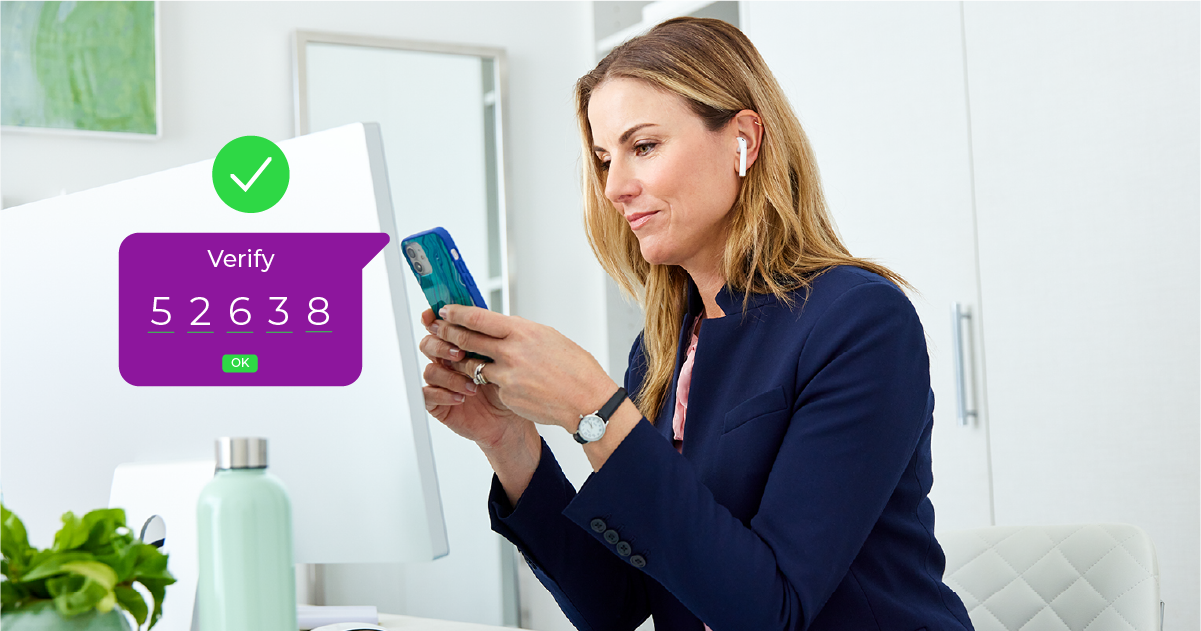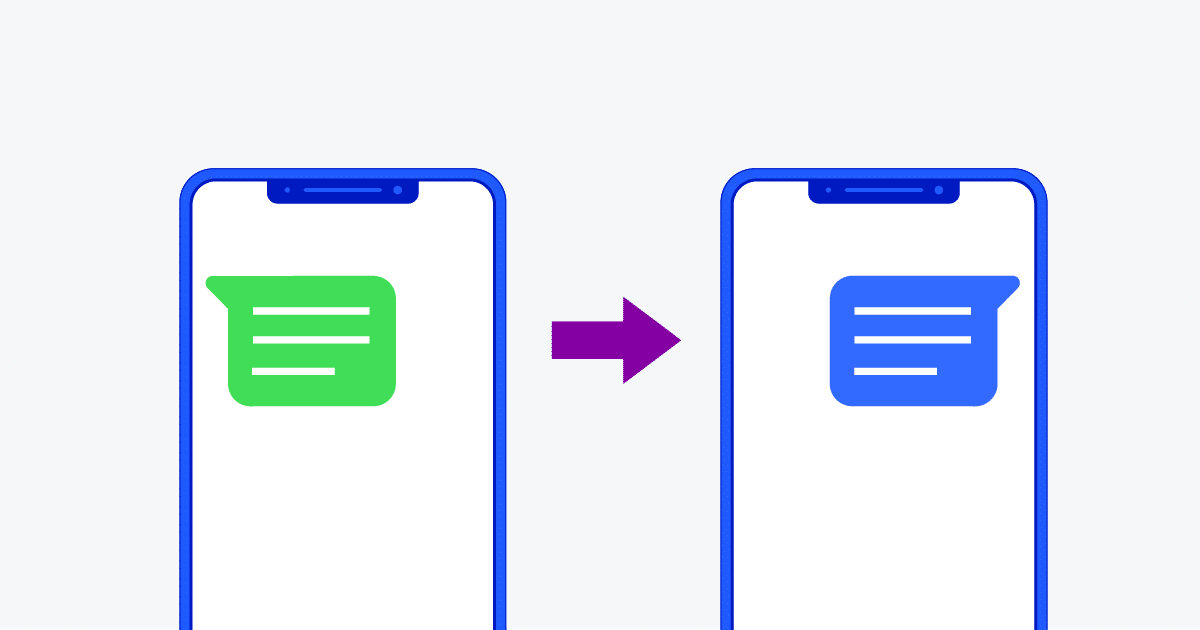
There was a time when securing an online account meant simply entering a username and password. But as digital threats have evolved, so have security measures.
Today, SMS verification plays a critical role in authentication, adding an extra layer of protection to keep accounts and transactions secure. But how does it work, and is it truly safe?
This article breaks down SMS verification—how it functions, industry applications, benefits, risks, and how businesses can strengthen security with phone intelligence and risk recommendations.
Table of Contents
What is SMS?
SMS stands for Short Message Service, and it is a type of text messaging that occurs on most smartphones and mobile devices. The length of SMS messages is limited to 160 characters.
What is SMS verification?
SMS verification is a security measure used to confirm a user’s identity by sending a one-time passcode (OTP) via text message to their registered phone number. This SMS confirmation ensures that only the rightful user has access to the account. The SMS validation code must be entered correctly within a short time frame to complete the authentication process, typically after a user has input their sign-in details. This extra step of security allows businesses greater control over who accesses their platforms.
As a form of two-factor authentication (2FA) or multifactor authentication (MFA), SMS verification acts as an extra layer of security beyond traditional passwords, reducing the risk of unauthorized access, fraud, and account takeovers. Many businesses use SMS account verification to confirm new registrations, secure transactions, and enhance user trust.
Why is SMS verification important?
With the increasing threat of password breaches and identity fraud, SMS verification helps businesses:
- Prevent unauthorized sign-ins and protect sensitive account information.
- Reduce fake registrations and bot activity.
- Ensure compliance with security standards (e.g., GDPR, PSD2, CCPA).
- Improve user trust with secure and low-friction authentication.
How SMS verification works
- User sign-in: When a user attempts to log in to an account or perform a sensitive action, the system activates SMS verification to confirm identity.
- Code generation: The system generates a unique, time-sensitive one-time passcode (OTP), often consisting of six digits, which is valid only for a short period to enhance security.
- SMS delivery: The SMS code verification is sent via a text message to the user’s registered phone number. This step ensures that only individuals with access to the registered device can complete the verification process.
- User input: The user receives the SMS verify code and enters it into the application or website as prompted.
- Verification: The system compares the entered code with the one it originally generated. If they match, the user is granted access. If the user fails to enter the correct code within a set number of attempts, they may need to request a new one.
SMS verification across industries
Many industries rely on SMS verification to enhance security and prevent fraud. While alternative verification methods exist, SMS remains widely used due to its accessibility and ease of use, especially as mobile interactions continue to grow across sectors.
Banking and finance
In the financial sector, SMS verification plays a crucial role in securing sensitive transactions and preventing unauthorized access to accounts. Financial institutions, including online banks and fintech platforms, rely on SMS account verification codes to verify user identity and authorize transactions.
Crassula, a financial technology company, partnered with Telesign to implement SMS authentication, ensuring secure access to accounts and financial services. By using SMS validation codes and mobile verification codes, Crassula reduced fraudulent transactions while maintaining a seamless user experience.
3.6 billion people worldwide use online banking services in 2025, underscoring the growing need for robust security measures like SMS verification.
E-Commerce
Online retailers implement SMS verification to protect user accounts, confirm orders, and verify shipping address changes. This process reduces fraud and improves customer trust in digital transactions.
Prezzee, a digital gift card platform, integrates SMS verification services to prevent unauthorized purchases and ensure legitimate transactions. By using an SMS verification website, Prezzee enhances customer security while streamlining the checkout process.
Global e-Commerce fraud losses are projected to reach $343 billion in 2027, underscoring SMS-based authentication as a vital tool for retailers to combat fraudulent activity.
Healthcare
Healthcare providers use SMS authentication to secure patient portals, confirm appointments, and authorize access to sensitive medical information, ensuring compliance with regulations such as HIPAA.
Blue Marble Health, a telehealth provider, employs SMS code verification services to authenticate patient identities and protect personal health data. By leveraging mobile verification codes, they minimize unauthorized access and enhance trust in digital healthcare services.
Recent studies show that 80% of individuals express a preference for using their smartphones to interact with healthcare providers. Even more so, 95.5% of patients reported feeling more connected to their care team after receiving text updates. This highlights the growing role of mobile communication in patient engagement, making SMS verification a seamless and trusted method for securing digital interactions in healthcare.
SMS validation features
SMS validation ensures that a phone number is valid and active before sending an authentication code. This step helps businesses avoid sending verification messages to invalid or deactivated numbers, improving efficiency and reducing costs.
How SMS validation works
- Phone number verification: The system checks if the phone number is properly formatted and active.
- Carrier identification: Identifies the mobile carrier to optimize message routing and prevent delivery failures.
- Risk recommendations: Assesses whether the number is linked to fraudulent activities or recent SIM swaps.
- Code delivery: If the number passes validation, the SMS validation code is sent.
How SMS verification protects against fraud
- Two-factor authentication (2FA): SMS verification plays a crucial role in two-factor authentication, adding an extra layer of security to password-protected accounts. By requiring users to verify their identity with a one-time passcode (OTP) sent via text message, 2FA makes it significantly harder for attackers to gain unauthorized access, even if they have stolen sign-in credentials.
- One-time passwords (OTP): One-time passwords are temporary, single-use codes that help protect accounts from credential stuffing attacks. Since these passwords expire after a short period and can only be used once, they limit the risk of hackers exploiting leaked or reused credentials to breach user accounts.
- Identity verification: SMS verification also serves as an essential tool for identity validation, ensuring that only legitimate users gain access to sensitive data and online services. This is particularly valuable in industries like banking, e-Commerce, and healthcare, where confirming a user’s identity is critical for protecting against fraud and unauthorized account access.
By integrating verify SMS code measures, businesses can enhance fraud protection measures and user security, reinforcing trust in digital interactions.
Is SMS secure?
How secure is SMS at its core? Unfortunately, the reality is that SMS is a huge target for cybercriminals. When a person sends a text message to someone else, there is a chance that prying eyes could intrude. This is because SMS messages are not end-to-end encrypted.
When something is encrypted end-to-end, the only parties able to read the messages are the sender and receiver. SMS messages are able to be read by third parties, including your wireless carrier. Though this is unlikely to happen, and could cross legal lines depending on the location, it is possible.
A bigger worry, of course, would be if a cybercriminal were to read your messages. As a standard, it makes sense to configure your important accounts with multifactor authentication, so in the rare case a hacker gains access to your SMS messages, they won’t be able to penetrate the other layers of your account successfully.
Benefits of SMS verification
SMS verification isn’t just a security measure—it’s a strategic tool that helps businesses reduce fraud, verify user identities, and streamline digital interactions. Here are some key benefits of SMS verification:
- Reduces undelivered messages.
- Protects against various types of fraud, including identity theft and account takeovers.
- Reduces the number of bots and fake users in any given digital ecosystem.
- Helps businesses confirm a person is who they say they are.
- Ensures sensitive information sent and received, such as messages and emails, is authenticated.
- Extremely low-cost—Saves costs on failed SMS delivery.
- Adds a layer of security on top of a username and password entry.
- Works to prevent potentially fraudulent financial transactions.
- Convenient, as many people already have smartphones, and are familiar with SMS verification processes.
- Improves conversion rates.
Potential downsides of SMS verification
Of course, SMS verification isn’t 100% impenetrable. Here are a few negatives to consider:
- Doesn’t fully erase the potential for fraud. To counteract this, safety systems should be implemented alongside SMS verification.
- Subject to the limitations of SMS message security. Without true end-to-end encryption, SMS will always have some risk for cybercriminals to see and exploit a user’s messages.
- SIM swapping remains a problem. This is especially the case when a company relies solely on SMS verification for security.
- Hardware and software don’t always mix. When you have a digital account protected in part by hardware, there’s a chance for a mix-up. For example, if a user misplaces their smartphone, they won’t be able to access their accounts. A recent study showed that 28% of smartphone owners have lost their phone before, with 5% saying their phone has been stolen.
- Not everyone has access to SMS. Some users may not have a mobile phone capable of receiving SMS messages, while others might be in areas with poor cellular coverage. To ensure accessibility, businesses can offer alternatives like voice or email verification.
To make the process more efficient and secure, an SMS verification API can be put into place.
Possible risks of SMS verification
While SMS verification strengthens security, it is not without risks. Cybercriminals have developed sophisticated tactics to bypass this authentication method.
SIM swapping: Attackers may hijack a user’s phone number by fraudulently transferring it to a new SIM card, allowing them to intercept SMS authentication codes. Once in control, they can bypass security measures and take over accounts linked to the compromised number.
Phishing attacks: Fraudsters often use phishing tactics to trick users into revealing their SMS verification codes. These attacks typically involve fake emails, websites, or messages that appear legitimate, persuading victims to enter their OTPs, which criminals then use to gain unauthorized access.
Delivery issues: SMS delivery is not always instant or guaranteed. Carrier filtering, network congestion, and regional restrictions can delay or block messages, preventing users from receiving critical authentication codes on time. This can lead to frustration and potential security vulnerabilities if users resort to less secure alternatives out of necessity.
Alternatives to SMS-based verification
While SMS verification remains a widely used authentication method, businesses are increasingly adopting alternative approaches to improve security and user experience:
- Push notifications: Secure in-app alerts that prompt users to approve or deny authentication requests, offering a more seamless and phishing-resistant verification method.
- Authenticator apps: Applications like Google Authenticator and Microsoft Authenticator generate time-sensitive, device-bound codes that provide an extra layer of security.
- Biometric authentication: Fingerprint scanning, facial recognition, and other biometric methods provide frictionless security without relying on SMS or codes that could be intercepted.
By combining SMS verification with these alternative verification methods, businesses can create a more secure and reliable authentication framework, reducing fraud risks while maintaining a smooth user experience.
Enhancing security with phone intelligence and risk recommendations
To mitigate risks, businesses can enhance SMS verification with additional security measures. Companies like Telesign offer advanced fraud protection solutions, including real-time risk recommendations and SIM swap detection.
By leveraging phone intelligence, businesses can assess a phone number before sending an authentication code, reducing the risk of fraud. Other protective measures, such as behavioral analytics and device intelligence, can further strengthen authentication processes.
Using an SMS verification API
Implementing an SMS verification API depends on your company’s specific requirements. To be sure you’re setting up a solution that best fits your needs, find a solution that offers a way to test out the process.
Be sure the provider you’re working with has a support team that is responsive and makes themselves fully ready to assist you with any questions.
When looking for an SMS verification API, you want a solution that goes above and beyond what you get from a basic verification process.
Look for the following factors in any potential provider:
- Offers a fully scalable and global (if needed) verification solution.
- Provides a quick OTP delivery, even at high volumes.
- Prioritizes security for all messages sent.
The future of authentication
While SMS verification remains a popular choice, the authentication landscape is evolving. Here are some emerging trends:
Passwordless authentication: A growing number of businesses are adopting passwordless authentication, reducing reliance on traditional passwords.
Biometric verification: Fingerprint and facial recognition technologies continue to gain traction, offering both security and convenience.
Push notifications: Authentication via push notifications is a rising trend, as it reduces the risk of SMS interception.
Authenticator apps: Authenticator apps, such as Google Authenticator and Microsoft Authenticator, generate unique, time-sensitive codes that provide a more secure alternative to SMS verification.
Regulatory compliance and SMS verification
Implementing SMS verification can help businesses comply with various data protection regulations:
GDPR (General Data Protection Regulation)
SMS verification supports GDPR compliance by enhancing user authentication and protecting personal data. Companies that fail to comply with GDPR regulations risk fines of up to €20 million or 4% of global annual turnover.
CCPA (California Consumer Privacy Act)
Businesses can demonstrate CCPA compliance by using SMS verification to protect customer accounts and sensitive information. Non-compliance can result in penalties of up to $7,500 per intentional violation.
PSD2 (Payment Services Directive 2)
For financial institutions in the EU, SMS verification can fulfill strong customer authentication (SCA) requirements under PSD2. A study by Mastercard found that 92% of European banks were ready to comply with PSD2’s authentication mandates by the 2021 deadline.
Telesign’s verification offering
When looking into the downsides and vulnerabilities of SMS verification, businesses prioritizing high levels of security may have concerns. These concerns are warranted, but they can be mitigated by pairing SMS verification with a solution that strengthens protection against fraud.
For example, if a SIM swap has previously affected a number, wouldn’t it be valuable to have a solution that automatically flags it? Telesign’s Phone ID provides this capability, analyzing risk factors associated with phone numbers to thwart fraud before it happens. That feature and more are what Telesign, the global leader in digital identity verification, offers.
What else does Telesign’s SMS Verify solution provide? Here are some key features:
- Toll fraud detection and protection: Toll fraud is a communications fraud where cybercriminals pump up traffic to premium rate numbers. These attacks negatively impact companies financially, especially those with high call/message volumes. SMS Verify helps prevent this, avoiding massive unnecessary fees.
- SIM swap recognition: SIM swap is one way that bad actors can gain control of a phone number’s messages, giving them access to verification codes. Telesign alerts you to this type of threat, provides a risk analysis, and allows you to choose whether to allow the SMS verification.
- Consistently lower rates: Telesign’s verification API uses phone number cleansing to avoid dialing rules that would otherwise cause higher delivery rates.
- Global verification possibilities: It’s important that your SMS verification abilities extend across the world, and Telesign ensures that by reaching 230+ countries.
- Keep your customers undisturbed and happy: Not all customers want to be told about your latest product or service. When that’s the case, you’ll want an automated, fast system to handle their opt-out requests. Telesign’s verification API automatically notifies when a customer opts-out.
Implementing SMS verification: Best practices
- Clear user communication: Explain the purpose and process of SMS verification clearly to users, emphasizing its security benefits.
- Provide alternatives: Offer alternative verification methods for users who can’t receive SMS messages, such as email verification or authenticator apps.
- Implement rate limiting: Set limits on the number of verification attempts to prevent brute force attacks. Research by security firm Akamai found that 28% of credential stuffing attacks can be mitigated through proper rate limiting.
- Use secure protocols: Ensure that SMS verification codes are transmitted and stored securely using encryption and secure protocols.
- Conduct regular security audits: Conduct regular security audits of your SMS verification system to identify and address potential vulnerabilities.
Streamline SMS verification with Telesign
SMS verification remains a vital security measure across industries, preventing fraud and enhancing account security. However, businesses must address its vulnerabilities and consider alternative authentication methods to strengthen security. Telesign provides industry-leading SMS verification services, combining fraud protection intelligence with seamless user authentication.
Ready to implement secure SMS verification solution capable of scaling globally? Talk to our experts today to learn more about how Telesign can help safeguard your business from fraud and protect customers.


